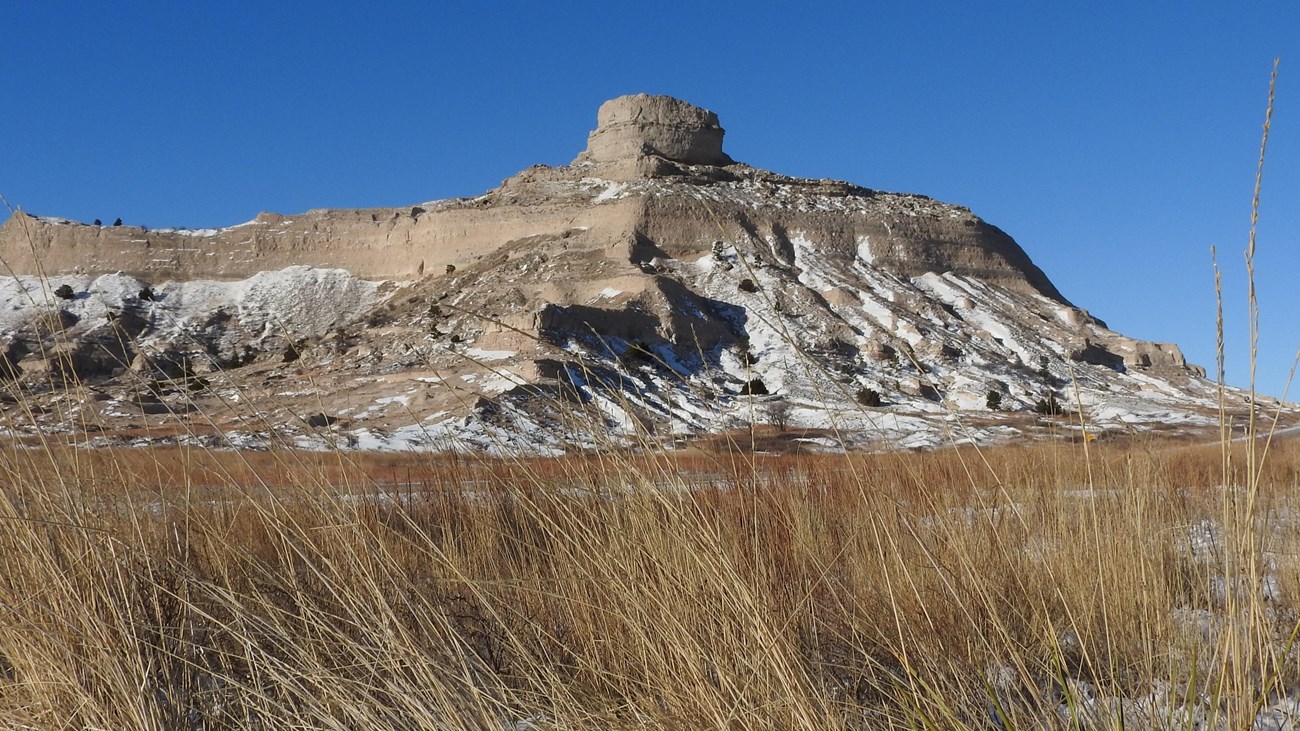Last updated: February 16, 2022
Thing to Do
Backcountry Hiking South Bluff

NPS/Eric Grunwald
The area within Scotts Bluff National Monument south of the Old Oregon Trail highway and directly across from the Visitor Center is known as “South Bluff”. The summit of South Bluff is 4,692 feet above sea level and is a relatively unspoiled area of considerable scenic value, abounding in features of geological and botanical interest.
South Bluff rises above the flat prairie in geologic strata of sandstone, siltstone, volcanic ash and limestone. This area is unimproved and there are no improvements planned. Of the five notable rocks within the monument, South Bluff features three: Dome Rock, Crown Rock, and Sentinel Rock. It is not permitted to climb Dome Rock, Crown Rock or Sentinel Rock because of the dangerously soft nature of the Brule clay formation that makes up their steep walls.
At the western end of South Bluff is Mitchell Pass. This pass is formed with Sentinel Rock on the south side of the pass and Eagle Rock on the north. The eastern end of South Bluff gradually lowers in elevation, forming isolated prominences of which Dome Rock is the largest. The western end remains at a significant elevation above the prairie. Between Sentinel Rock and Crown Rock is a “gap” referred to as Coyote Pass. Coyote Pass is 4,331 feet above sea level. South Bluff geology is similar to Scotts Bluff (to the north) and also has similar vegetation.
South Bluff rises above the flat prairie in geologic strata of sandstone, siltstone, volcanic ash and limestone. This area is unimproved and there are no improvements planned. Of the five notable rocks within the monument, South Bluff features three: Dome Rock, Crown Rock, and Sentinel Rock. It is not permitted to climb Dome Rock, Crown Rock or Sentinel Rock because of the dangerously soft nature of the Brule clay formation that makes up their steep walls.
At the western end of South Bluff is Mitchell Pass. This pass is formed with Sentinel Rock on the south side of the pass and Eagle Rock on the north. The eastern end of South Bluff gradually lowers in elevation, forming isolated prominences of which Dome Rock is the largest. The western end remains at a significant elevation above the prairie. Between Sentinel Rock and Crown Rock is a “gap” referred to as Coyote Pass. Coyote Pass is 4,331 feet above sea level. South Bluff geology is similar to Scotts Bluff (to the north) and also has similar vegetation.
Details
Duration
60-180 Minutes
The amount of time spent hiking South Bluff is dependent on the fitness of hikers and the amount of time exploring the features of the bluff.
Activity
Backcountry Hiking
There are no marked walking or hiking trails on South Bluff. It is accessible only by means of a steep and difficult draw or by a wide detour up a ridge far to the west and off the Monument boundary. It is not permitted to climb Dome Rock, Crown Rock or Sentinel Rock because of the dangerously soft nature of the Brule clay formation that makes up their steep walls. You are free to ascend South Bluff or roam on foot through this area on either side of Mitchell Pass; however, no fires or overnight camps are permitted. Rough clothing and stout footgear are recommended. Because there are no trails, it is suggested that you let the Park Rangers in the Visitor Center know when you are climbing South Bluff. Please check in at the visitor center to let the rangers know there will be hikers on South Bluff. Always be alert for rattlesnakes when you hike the bluffs and avoid trespassing on the private land that surrounds the monument property
Age(s)
1-99
Hikers of any age can explore South Bluff. However, all hikers must be prepared for a strenuous and primitive hikng experience with steep grades, loose rock, and absence of trails and the possibility of encountering rattlesnakes.
Pets Allowed
Yes
All pets must be on a six-foot leash. Please clean up any pet waste.
Activity Fee
No
Entrance fees may apply, see Fees & Passes information.
Location
South Bluff
The area within Scotts Bluff National Monument south of the Old Oregon Trail highway and directly across from the Visitor Center is known as “South Bluff”.
Reservations
No
Season
Year Round
South Bluff may be hiked at any time of the year. However, spring and fall tend to offer the most comfortable hiking conditions.
Time of Day
Day
Scotts Bluff National Monument is open sunrise to sunset. No camping is permitted on South Bluff or elsewhere in the monument.
Accessibility Information
Hiking South Bluff is off-trail with steep inclines and loose rock.
